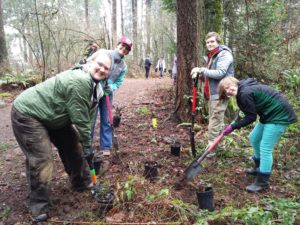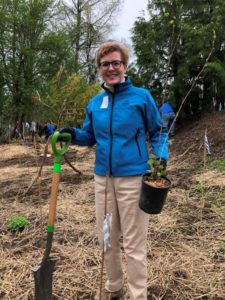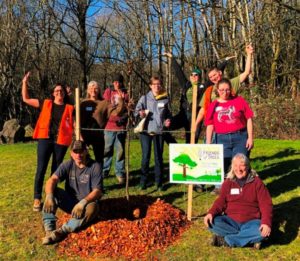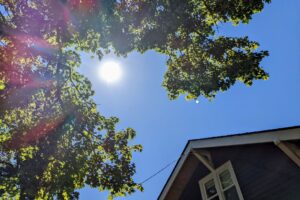Tag: canopy
Heat Week 2022
Addressing heat concerns in our community
In June 2021, the Pacific Northwest was embroiled in a heat dome effect, reaching high temperature records from Oregon to British Columbia. We had a cool and wet spring, but another June heat wave this week served as a reminder that we need to be prepared for more frequent and intense weather events.
This year, Heat Week was created to help the community learn how to prepare their households for warmer summers and take action together to cool our neighborhoods. Friends of Trees is proud to be a part of this work, because trees provide a powerful cooling effect to communities.
Heat Week is a series of events organized to commemorate the historic Heat Dome of June 2021, remember those who died due to disparities across our community, and bring together practitioners, professionals and community leaders to share information and resources across a range of heat and climate related topics. Heat Week kicked off on Sunday with an event at Leach Botanical Garden, where leaders and experts commemorated those who died during the extreme weather last year and made calls to address climate change.
“Communities at this higher latitude are arguably the most underprepared for these kinds of events,” Portland State University Professor Vivek Shandas said. “We saw that really bear down on us last year.”
Heat Week includes five days of events for professionals and community members across the Metro region. These include a mix of in-person and virtual events, most of which are open to the public. By sharing resources, data, and quality information with our growing network of heat adaptation professionals, Heat Week is creating needed discussion around climate realities—discussions meant to serve the larger public.
Heat Week was initiated by CAPA Strategies, a climate adaptation and planning analytics company that is motivated by community collaboration and resilience. Partners include Portland Bureau of Emergency Management, Families for Climate, Multnomah County Health Department, Washington County Health Department, Clackamas County Disaster Management and Public Health, National Oceanic & Atmospheric Administration, Verde, Familias en Acción, 350 PDX, Community Energy Project, and Friends of Trees.
Trees & Health Symposium in Gresham on Nov 13

We all know that trees provide benefits to people and the communities they live in.
But do you know how to care for trees to help them thrive, and how you can add to Gresham’s tree canopy at home or in your neighborhood?
The Gresham Trees and Health Symposium will feature a mix of speakers, film, discussion, tree care booths, light refreshments, and a summary of the City’s Green Gresham, Healthy Gresham tree project in Rockwood.
Wednesday, November 13, 2019
6:00 – 8:00 PM, Rockwood Boys & Girls Club
More information and registration information is here, thank you to our co-hosts Multnomah County and City of Gresham!
Get to know our partner: Portland General Electric

PGE has supported Friends of Trees since our beginning, contributing time and funding toward our shared goals of greening our region and building community.
As Friends of Trees has grown, PGE’s support has grown. PGE has sponsored hundreds of tree planting events over the past three decades, and its employees have donated hundreds of volunteer hours. And in honor of 30 years of trees + community PGE has announced a special gift that will help Friends of Trees reach the milestone of one million trees planted since our inception.
“To celebrate Friends of Trees’ significant impact on our beautiful state, we’re investing $100,000 and volunteer power, over the next five years, coming together with the community and our customers to reduce carbon, strengthen neighborhoods and improve our environment.” -Kregg Arntson, PGE’s director of Corporate Social Responsibility
In addition to donating time and money, PGE partners with Friends of Trees to plant the right type of tree in the right place. This helps prevent tree-related power outages, contributing to safe, reliable power for customers.
Friends of Trees cannot plant 50,000+ trees and native shrubs every year without the support of sponsors like PGE. Their support, since our founding, has been key in our ability to plant 800,000 trees and native shrubs to date with tens of thousands of volunteers. We are just thrilled that PGE’s $100,000 pledge will help us get to the incredible milestone of one million trees planted.
This story is from the Summer 2019 edition of our e-news, Treemail; check out the rest of Treemail here.
Get to know our partner: the City of Vancouver
 “Friends of Trees does more than simply plant a tree at a Vancouver resident’s house. They plant the right tree, the right way, in the right location.” -Charles Ray, City of Vancouver Urban Forester
“Friends of Trees does more than simply plant a tree at a Vancouver resident’s house. They plant the right tree, the right way, in the right location.” -Charles Ray, City of Vancouver Urban Forester
For 16 years Friends of Trees has been planting the right trees, the right way, for Vancouver residents in partnership with the City of Vancouver. Currently more than 500 trees are planted every year here, thanks to the help of hundreds of community volunteers.
Vancouver’s Urban Forester, Charles Ray, reflects on this long-lasting, impactful partnership, and the important role trees play in the community,
“Vancouver has a long history with trees and considers trees community assets that provide multiple benefits, including clean water. The simple truth is trees in the community have practical, quantifiable values and are not merely decorations. They provide essential benefits that we cannot live without.
“We are fortunate to have an organization like Friends of Trees that shares the same mission and helps us accomplish more. Most municipal programs across the country dream of having an opportunity such as this. Friends of Trees does more than simply plant a tree at a Vancouver resident’s house. They plant the right tree, the right way, in the right location.
“Friends of Trees engages that person several times through the process, enabling staff and volunteers to share the benefits of trees and educate them about the City’s processes and requirements around trees. It also offers them an opportunity to engage hands-on with the community asset, the tree that will be planted in front of their house. This often leads to stronger community connections and civic involvement, and knowledge of the benefits, how to care for and needs of the urban forest.
“Planting the right tree in the right place and giving it the right care and pruning make all the difference to ensuring a healthy urban forest today and for generations to come. It only takes a minute to improperly prune or remove a tree but a lifetime to grow one.
“We cannot do it alone. I am excited by Friends of Trees’ commitment to Vancouver and the community’s efforts to meet this need. If I could ask for one thing it would be participation from the business community to sponsor plantings so that we can increase our annual planting goals with Friends of Trees.”
Charles, we couldn’t say it better ourselves; Vancouver businesses, join us!
Pictured above: Far left, Jessica George, City of Vancouver; standing, third from left, UF Program intern Bruce
This is from the April 2019 edition of our e-news, Treemail; check out that issue of Treemail, and others, here.
Neighborhood Trees Program FAQ
 Some of the Why, Where, and What-Have-You of planting trees in the city with Friends of Trees
Some of the Why, Where, and What-Have-You of planting trees in the city with Friends of Trees
Since 1989 Friends of Trees has been growing our urban canopy through planting street and yard trees in neighborhoods. A LOT changes during 30 years of tree planting! We continually work with our city and county partners to ensure the right tree is planted in the right place, and since every location is different we are used to getting quite a few questions. Here are answers to some of the questions we get the most:
I want a smaller/larger tree for my planting strip but all the trees on this list are just too big/small, why can’t I get a smaller/larger street tree?
We work closely with our municipal partners and we can only plant trees that are on their approved street tree planting lists. One of the goals of our program, and the partners we work with, is to increase the urban canopy in order to maximize the benefits. In other words, the larger the tree, the more the urban canopy grows, which provides more benefits in terms of cooling in the heat of summer, providing oxygen, and cleaning our air and water. So when a planting site allows it we need to optimize the size of the tree planted, and consequently, maximize the benefits provided. We also want to make sure we aren’t planting trees that are too big, in order to protect existing urban infrastructure. So these same guidelines ensure we aren’t planting over-sized trees in spaces that are too small.
I want to plant a fruit tree in my planting strip and I know you have them, why aren’t they on my list of approved street trees?
Fruit trees are only approved for certain spaces, such as yards or planting strips that are six feet or larger and have overhead primary power lines (however, Vancouver and Clark County do not allow fruit trees to be planted as street trees at all). If you’d like a fruit tree for your yard in addition to your street tree, we offer a wide variety, including apple, pear, plum, fig, and persimmon.
I only want native trees for my street tree and you only have one native on this list, why don’t you plant more natives?
Right Tree Right Place! We love native trees, but many tend to get pretty big and just won’t work in some planting locations due to overhead power lines, if the strip isn’t wide enough, a nearby intersection, etc. We want to make sure your tree is the best tree for your planting spot! We also want to plant as diversely as possible toward a resilient urban forest. P.S. Want to plant some natives? Join one of our Green Space planting events–all natives, all the time.
I want a street tree, but will it break the sidewalk?
Again, Right Tree Right Place! The trees offered by Friends of Trees do not have aggressive root systems and are specially approved to minimize such conflicts. Proper watering also helps. Deep watering for the first three years after planting encourages tree roots to grow deeper in the soil, we recommend 15 gallons a week during the summer for the tree’s first three years, and as needed in the future when temperatures are extreme. Keep in mind that we cannot guarantee that the trees we offer will never buckle sidewalks, as they are living beings and situations vary. We do our best and encourage you to keep an eye on your tree.
I’m concerned that tree roots will damage the sewer pipe, doesn’t this happen?
A tree’s roots grow where the growing is easy, they are opportunistic and not invasive. They do not seek out water or sewer pipes unless the pipes are leaking. Further, 90% of tree roots are in the top 2-3 feet of soil, and most sewer lines are deeper than that. Your municipal tree inspectors take into account the location of your water meter and assigns the planting location within the guidelines of the water company.
Can you help me remove a tree so I can plant a new one with you?
We can’t help you with a tree removal, but you can re-plant with our program if the city allows you to remove your tree. If you want to remove trees in your yard, check with the city to see if there are laws affecting your tree. To remove a street tree, you need a permit. Contact your city’s urban forestry department directly for a removal inspection, a list of contact information for our municipal partners is here. It’s a good idea to request that the city mark “all approved locations.” If you want to re-plant with us after removal please include on your application that you are working with Friends of Trees. Visit our website for more information about tree removal and replacement.
The approved locations where the trees are going are strange, can you change the location?
Unfortunately we can’t change the location. All street tree locations are based on a city inspection, and there are many factors involved, including distance from underground utilities, overhead lights and power lines, utility poles, fire hydrants, intersections, and street signs. Planting in the spot chosen by the inspector will help ensure your street tree has the best shot at surviving–and thriving!


 Some of the Why, Where, and What-Have-You of planting trees in the city with Friends of Trees
Some of the Why, Where, and What-Have-You of planting trees in the city with Friends of Trees